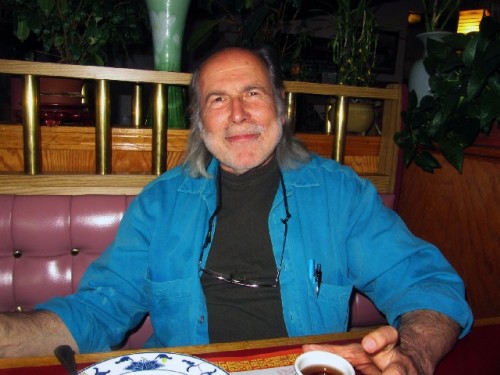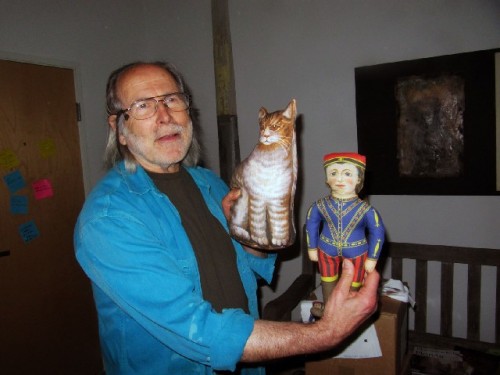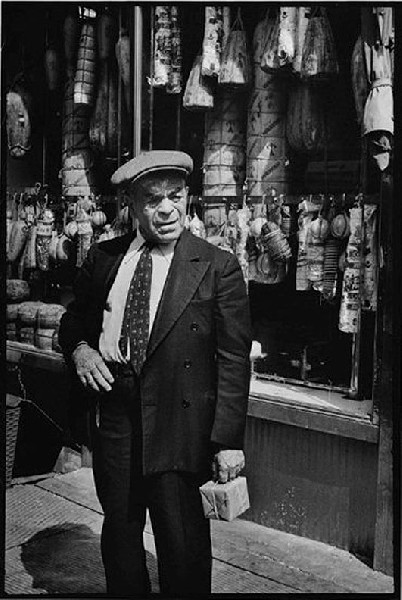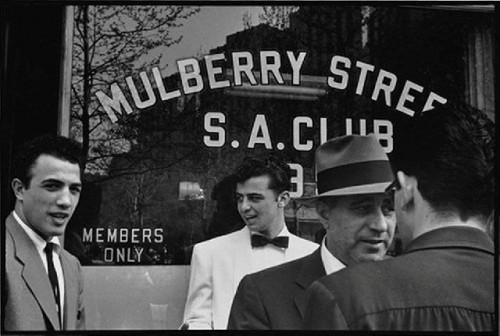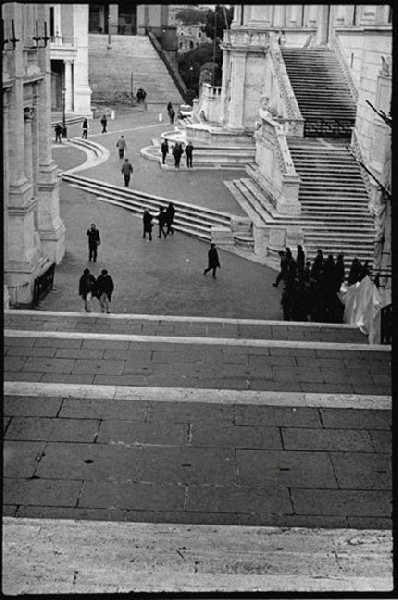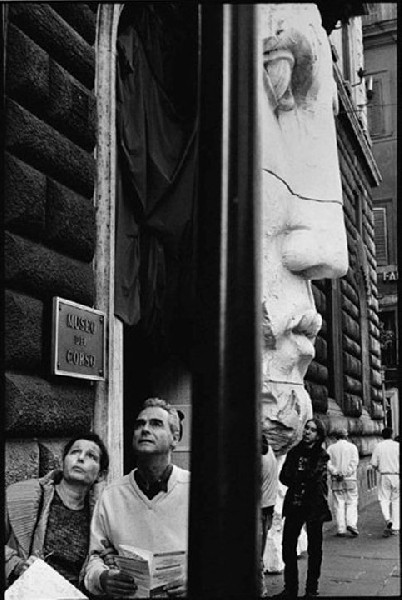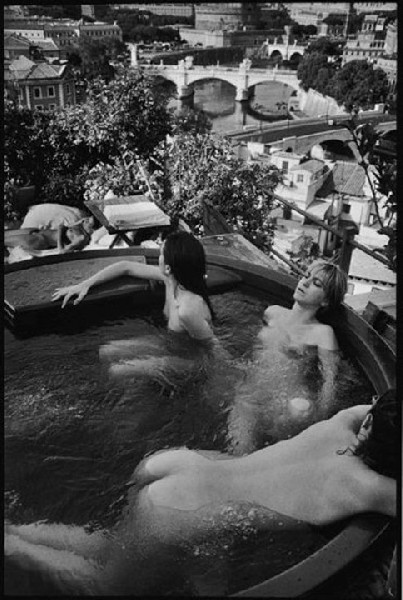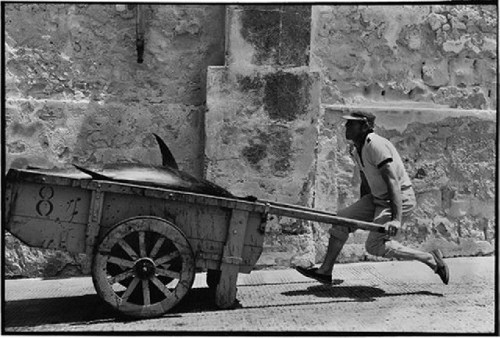Ralph Brill on Photographer Leonard Freed
Eclipse Mill Exhibition and Other Projects
By: Ralph Brill and Charles Giuliano - Jun 05, 2012
Charles Giuliano Let’s discuss your relationship with the late photographer Leonard Freed.
Ralph Brill I knew Leonard for thirty years. He was a personal friend and his wife Brigitte worked with me. A Freed retrospective was the first exhibition when I came here and opened a gallery in the Eclipse Mill. That was in 2006 and I was only coming here on weekends. Freed died in November of 2006. He was scheduled to come for the opening but was too weak to do that. Brigitte came up instead. It was a mixture of different photographs. There was no specific theme at that point. It was a cross section. A week later he died of prostate cancer. Partly because I knew him and partly because I have good ideas. So I got to expose Leonard’s work to institutions that knew his work and lots of new places. Since 2006 I have sold Freed Collections to the Folkwang Museum in Germany, Davison Art Center at Wesleyan University, Smithsonian Institution among other important museums internationally.
At least once a year there is stuff going on globally. Not that I’m in charge of everything. There are projects that others are working on. In Switzerland, France, Germany and different places. Also as a Magnum photographer his works are displayed in their galleries around the world. There is an American graduate student who happened to be in Germany and saw one of the famous Leonard Freed photographs. It was an image of a black American soldier standing next to the Berlin Wall. It stuck in his mind and he said that he was going to make his PhD thesis on him as a result of that. Paul Farber is with the University of Michigan.
Two years ago there was an exhibition of Freed’s work at the Getty Museum in LA. The Getty republished one of his books. Just finished was Freed’s Police Work exhibition at The Museum of the City of New York. This summer there is a photo exhibition at the Tate Modern in London that includes several of Freed’s photographs.
CG How many books are there?
RB Fourteen. One of the books he published in the ‘60s was called “Black In White America.” It was one of the books that got him huge international attention. Because it was out of print the Getty wanted to reprint it. They reprinted it a couple of years ago. Paul, looking through the files, said “Leonard took some beautiful shots during the March on Washington.”
During the whole Civil Rights period most photographers were shooting some poor black kids getting smacked on the head or bitten by German Shepherd police dogs. Something dramatic like that. Somebody being hung and so on. Leonard never did that kind of thing. He always took pictures of people looking like people but in interesting ways. Paul said, “You know what. This coming year (2013) is the fiftieth anniversary of the March on Washington.” While everyone was taking pictures of Martin Luther King, and the big people up front, Leonard was in the crowd taking pictures of their reactions. Paul found it to be so beautiful that he proposed it to the Getty and there is a book coming out. So there are a handful of people around the world who are excited about Leonard’s photographs and propose book projects and the like.
CG Based on your personal relationship can you describe him as a friend and as an artist?
RB He grew up in a Jewish family of Russian parents in Brooklyn. He wanted to be an artist and studied a little bit about it. While snooping around New York he went to Little Italy. He said that all of a sudden he caught the different smells. People wearing black. They dressed differently than we was used to seeing. The food was different. He fell in love with it. He ended up moving to Little Italy in the '50s and he was next-door to Marlon Brando.
CG Did they know each other?
RB Just as neighbors.
CG At that point Brando was probably a roommate of Wally Cox (Mr. Peepers of early TV). They were probably students then at the Actor’s Studio.
RB People were attracted to Little Italy then as being the West Village in the ‘50s. Then he got a camera and he saw that as a tool by which he could communicate. He took pictures and a bit of writing as notes to himself of what he was looking at.
CG Did he do his own darkroom work? Most of the Magnum guys just sent the film in.
RB That’s 100% right. He did do his own darkroom work. He didn’t become a Magnum photographer until the 1970s. He was picked to be in the Museum of Modern Art show the photography curator there said he thought of him as being an up and coming photographer. At that point he did all his own prints. One day he decided to go to Italy and that’s how he met Brigitte, his wife. He wanted to get away from Brooklyn and he thought he could make a living shooting for magazines. He was living in Amsterdam and shot for Der Spiegel and other magazines. It was a struggle and it wasn’t until he made that image I mentioned of the black soldier. He had heard about what was going on in America but didn’t go back. When he shot the black soldier in his mind he said “What is this guy doing here? The action is in America.” So he couldn’t quite grasp it. He packed his bags and said “I’m going to try to understand this.” He traveled through the South and took these pictures and so on. He put those images together as a book and that was the start of his reputation.
CG What is the extent of the work? At this point is it archived?
RB There are thousands of images. Magnum has files. Scans. They have scans. Brigitte has the Leonard Freed Studio which she manages in Upstate New York. It is very well organized. She learned how to print and printed with him in the early days. Before there were computers she worked with him filing this vast quantity of subject matter. Every image now has an index number. She can locate it. There are thousands of prints some of them vintage. Some of them later prints. Hundreds signed by him. Because she has negatives she can make prints if she chooses to on request.
Regarding the blacks in the ‘60s he took them as human beings and not as people being beaten up.
CG How do you remember him personally?
RB He was traveling a lot. So he was not somebody who was around a lot. He had a studio in NYC. Lived upstate. Didn’t talk that much. Some people don’t talk that much. If you cornered him or were talking with him on a subject of interest he could talk for hours. He always had a camera with him. Even in the end he was shooting in the hospital.
The reason there are a lot of books being done now is because they realize how important an eye he had. He captured periods when no one else was shooting. Now it’s fifty years later and people want to tell these stories. One that you saw in my gallery is about Indonesians in Holland. At one point the Dutch controlled Indonesia and a vast part of that territory. They have gained their independence since then. But a lot of Indonesians came to Holland. In the ‘50s when Leonard set up shop there he was taking pictures of what was going on. Now there is the Tropish Museum in Amsterdam. It means the Museum of the Tropics. Two years ago they had a big show of his photographs showing how Indonesians are functioning within Dutch society.
A young Dutch photographer contacted Brigitte stating that “I am a descendant of a mixed family. I love what Leonard has done and I would love to do a book.” She came and spent the summer with Brigitte. It is one of the prettiest books. Very cleverly made. She got a publisher in Holland. This exhibition was so successful that it was extended and they bought that collection.
CG You did the Italian book.
RB I’m in Italy three or four times a year. I have a place in Tuscany. I developed a relationship with officials in the US Embassy in Rome. For fifty years Italy was Leonard’s favorite place. He met his wife there and was inspired early on by the smells and tastes of Little Italy. If he had three weeks. You asked me the question of what was he like. He did not hang around. If there were weeks available he was in Italy. In the last years of his life he was in New Guinea or the Brazilian jungles. He wanted to do things. From the 1950s through 2004, which I think was his last year in Italy, he went and took pictures. Again the same thing. Most photographers take pictures of landscape and historical buildings. He mostly focused on the people.
I discussed doing an exhibition with the embassy. We massaged it and massaged it and eventually it got down to last year, which was the 150th anniversary of Italy as a country. We thought wouldn’t it be great to give a gift from the Americans to the Italians. So they asked could you put together an exhibition which would travel and a book. The US Embassy gave its support. In Italy there are regional cultural centers. There are regional arts councils which support it. It became Leonard Freed: The Italians
It’s in Rome for a couple of more weeks and then it will go to Turino and Palermo. The book has about 210 photographs and the show has about a hundred. I’m going to be putting the images on my website. So people who can’t see the exhibition will be able to access the work and order prints. I’m experimenting with this.
CG Don’t you plan to show the work at the Eclipse Mill Gallery?
RB Yes. 20 July to 19 August 2012. The gallery is not big enough to have the whole show and I don’t have all of the prints here. There will be a good selection. I am working on trying to connect with the Italian community in the Berkshires. They will be invited to the opening. So hopefully there will be a lot of Italian people here and they will connect with this exhibition.
CG I guess that includes me. Is there a significant Italian community in the Berkshires? One mostly hears about the French Canadian, Irish, and Polish who came to work in the mills.
RB I don’t know who they are. I have been in communication with a couple of people who have been putting me in touch with Italian community groups. I don’t know enough about them yet. They came as workers. You know Jennifer Huberdeau (reporter for the North Adams Transcript). Her grandfather is Italian and came here to work with Arnold Print Works. A lot of Italian artisans came here in the late 1800s to 1920s. That’s one of the main reasons I do the Arnold Print Works dolls.
Most people you talk to remember back to the 1980s and Sprague. But back in the 1890s there was a huge arts community here when Arnold was doing very elaborate designs on fabric. This goes back before 1942 when Sprague took over the North Adams campus. Arnold was here long before that. In the period between the 1850s to the 1940s. They owned most of the mills around here. They needed material to do their designs. In the lobby of MASS MoCA you will see a placard that states this was Arnold Print Works before it was Sprague.
That’s another reason why MoCA is interested in the dolls (recreations of Arnold designs) because it helps to reinforce that connection.
CG What happened to Arnold Print Works?
RB In the 1890s it was the largest printworks in the world. Just like later Sprague was the largest capacitor maker in the world. For Arnold the manufacturing was here but they had offices in New York and London. This is so interesting. If you go back to that time in the 19th century some 80% of people wore wool. It’s hot and difficult to clean. When cotton came about millions of yards had to be created. A whole continent was shifting from wool to cotton. It turns out that our Southern fibers were among the best. That’s why there were over 3,000 workers in North Adams. The Eclipse Mill was a part of it. They were pumping out miles of printworks. The Eclipse Mill took the raw material and made thread. It went to another mill to be woven into sheets. Then sent to Arnold to be printed.
It was also happening in Adams. When you drive into town on the left is a large building that is now converted to apartments. Who owned that? Berkshire Hathaway. At one point it was a part of one of the country’s largest empires. Now it is Warren Buffett’s company. He bought the company out of bankruptcy and kept the name. He bought it in the 1950s.
CG You have such a range of interests that it is difficult to get a fix on who you are and how you function. Clearly you have a grasp and curiosity about history. It informs your approach to researching projects. You have training in architecture. In some ways your interests are so diverse it is difficult to see how they gel into projects.
RB In a sense my training in architecture is helpful because you start by looking at a tract of land. What’s underneath it. The structure. Then you have to understand who is going to use it. How long is it going to be used? What are the materials that are available? So I think that way. When my kids were in school they were asked what do your parents do? With their mother it was easy they wrote down lawyer. With their father they had to learn how to spell entrepreneur.
I had an organic farm in Vermont which is how I got up here. I had a farm for fifteen years so I am very involved with food as my kids are.
CG Your daughter makes muffins.
RB Cookies. Sweet Lorens. WWW.Sweetlorens.com In just one year she is in all the East Coast Whole Foods. On Monday morning she’ll be on Good Morning America.
CG Can we discuss the large project you are working on. As I understand it you have done a critical analysis of the economics of the Berkshires. Of course the primary reason that many of us came here has been for arts and cultural tourism. Manufacturing is no longer viable as it was during the era of Arnold Print Works and then Sprague Electric or General Electric in Pittsfield.
RB Using the antennae that you’ve described as how I work, it turns out that North Adams was built on misery: Slavery, Child Labor and War. Not many people realize this but North Adams was home to some of the major slave owners in the South. It’s understandable when you start to scratch at the surface. If you handle this much cotton you better get the cost down and control the raw material. Slavery in New England started in Massachusetts in the 1600s.
Have you heard about Mayor Houghton? Do you know where the Masonic Temple is? On Church Street? That was his house. He was president of Arnold Print Works. He was president of the bank. A lot of the banks here owned slave ships. North Adams had a deal with slave capturers in Madagascar. They brought slaves to Cuba, the West Indies, and most importantly to the South. I’m going to be holding a symposium on that this summer.
Child Labor was the next way of getting the cost down.
CG That was the subject of your exhibition The Mill Children which opened last summer at the Eclipse Mill Gallery and is still traveling. Most recently in Waltham.
RB By 1916, five years after those (Lewis Hine) photographs were taken it pretty much stopped. Most it came through emotional changes in the country after the Child Labor Commission Reports. But unions started to be formed and the union workers said “we need the jobs.”
CG Just to retrack. You said that North Adams was founded on misery.
RB North Adams was founded on misery that included: Slavery, Child Labor and Wars. The biggest contracts that produced revenue for Arnold Printworks to do other things were to make tents and uniforms during the Civil War. Similarly it was through World War Two contracts that Sprague earned money.
In the past ten years of the Iraq and Afghan wars, for the first time, we have nothing. There’s only one small company that has a contract welding things. Bennington has $200 million in contracts. Pittsfield has $200 million in contracts. We have no jobs. North Adams hasn’t learned to function as an entrepreneurial city so it’s in limbo.
This is why I’m suggesting that it needs a new vision. The wellness and health vision is the one that I’ve come up with.
CG So North Adams is still miserable.
RB Yes and the demographics and stats prove it. 63% of all the commercial buildings are vacant. The hospital is bankrupt. There are hardly any young people moving in. There is a lot of very solid data that shows that if there isn’t a correction of some sort bad things can happen,
CG Where does MASS MoCA come into your research?
RB MASS MoCA is a very big success story. What I am saying to MASS MoCA, the Clark and WCMA (Williams College Museum of Art) is that the local arts community is dead. At this phase. Part of that is that this economy is very difficult on young living artists. You need to have a second home spending environment. Until 2008 you had that. People were buying homes in Vermont and the Berkshires. When you do that you have walls that you need stuff on. People came and bought things. Since 2008 the market for most young artists in this area has disappeared. Artists came here thinking that being close to MASS MoCA would have some benefits. Which is why I’m here and maybe why you’re here? It worked to a certain extent but the economy put brakes to it.
The surrounding cities are bigger and have an arts vision compared to North Adams which has a MASS MoCA vision. So you have MASS MoCA controlling one part and Gallery 51 controlling another part. Artists aren’t comfortable in that kind of situation. They want to have more free form. Pittsfield has enough money to have a full time arts director (Megan Whilden).
Northampton, Brattleboro, Troy all have people on staff who are focused on making nice to artists. They believe that artists are an important ingredient in the texture of these cities. We don’t have it. I don’t mean that we don’t have enough DNA here that it’s going to stop and end. But for this phase it has ended.
I have suggested a piece of the puzzle that nobody seems to grab here - the China connection

